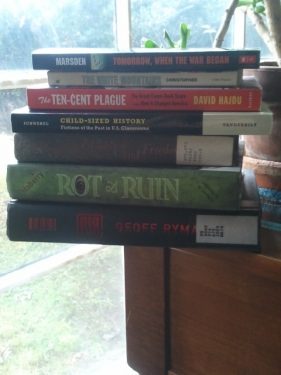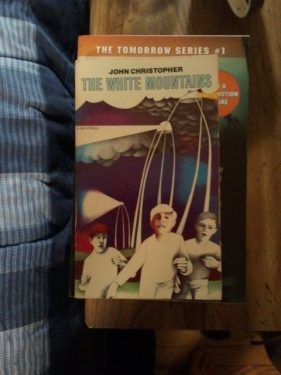Last year around this time, I wrote a blog post that was a blatant copy of a post that Adam Golub, an alum of my graduate program and a faithful Tweep, had contributed to Forbes.com. This was the Holiday Bookbag, a simple rundown of the group of books that you decide will be your companions on the airplane, the parents’ living room rug, and the couch, in this season of sloth and minimal work obligations. Unbelievably, a year has passed, and I’m at the beginning of a week or so of blissful Chex Mix-eating and reading by the Christmas tree; the Bookbag post seems like it deserves to become a tradition.
This year I flew north for the holidays, so my bookbag is skimpier than last year’s; no Volvo bookmobile for me. In evaluating my choices, I have noted a sad lack of a traditional component of the holiday book array: the Completely Outside Of My Subject Area volume. There seem to be a few too many young-adult novels and histories of childhood in here for my Bookbag to qualify as fun. However, I’ve asked Santa for a few that could lighten the load (including the Library of America’s first volume of HL Mencken’s Prejudices), so here’s hoping. (Now that it’s too late, I totally wish I’d asked for D. Graham Burnett’s Trying Leviathan: The Nineteenth-Century New York Court Case That Put the Whale on Trial and Challenged the Order of Nature; that’s the perfect holiday book, not least because it reminds me of the halcyon days of Christmas 2008, during which I got to read Moby-Dick for my oral exams. If anybody reading this needs an Xmas gift idea for me, there’s your freebie.)
The White Mountains, by John Christopher (NY: Scholastic, 1967). Just bought this for $2 at Athens Book Center, a combo used-new book shop in my husband’s hometown with a good science fiction section and troves of old magazines and comics. I grabbed this book when I saw the title on its spine, thinking it might be about my beloved White Mountains of New Hampshire; the cover got me for sure, as did the blurb on the back: “Will and Jack expect to be capped as soon as they are fourteen. They sometimes wonder, though, what it was like before the giant Tripods ruled the land—before people’s heads were ‘capped’ with small, metal discs.” The discs make people docile and stupid, saving the alien overlords the trouble of controlling them. This plot reminds me of Scott Westerfeld’s Uglies trilogy, in which teenage citizens are automatically given a series of surgeries that make them beautiful, but leave them with lesions on their brains that render them incapable of independent thought. It also seems like a classic example of 50s/60s fears about conformity. I have no idea whether the book itself will be any good.
Tomorrow, When the War Began, by John Marsden (New York: Scholastic, 1993). Although this book, the first in a trilogy, is now a movie (with a slick website), I’d never heard of it before seeing it at the Athens Book Center in the “Employee Picks” section (yay for flesh-and-blood bookstores!) The plot is similar to the movie “Red Dawn“—a group of teenagers hide in the wilderness and launch sneak attacks against the invading force that has taken over their hometown. Since this takes place in a small town in the middle of a cattle-ranching district in Australia, the kids—including the girls, of which one is the narrator—are really used to being in the outdoors, and wily and resourceful in the landscape. I read this one in a flash yesterday afternoon (yay, free time), and loved it. I’ll be getting my hands on the second one soon.
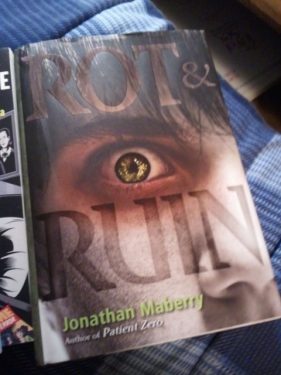 Might as well do all the young-adult ones in a row. Rot & Ruin, by Jonathan Maberry (Simon & Schuster, 2010) was a recommendation from another Tweep, Chris Tokuhama, who shares an interest in young-adult dystopias. This zombie story, which I zapped through on the plane ride from Texas to Ohio, takes place fourteen years after the downfall of society; the young protagonists live in a walled-in small town with adults who are too scared to use electricity or travel. Like another good zombie book I read recently, Mira Grant’s Feed, this one is more about the way that survivors handle fear in the long term than about vivid scenes of zombie battle in the immediate aftermath of an outbreak. The bad guys here are the powerful bounty hunters who roam the abandoned, zombie-filled countryside, taking advantage of societal instability to do whatever they want. Arch-villain Charlie Pink-eye can’t scare me too much after encountering The Walking Dead’s terrible The Governor (he’s in the graphic novel—no TV spoilers, I hope), but there is something very moving about the way that protag Benny Imura begins to come to terms with his own humanity, while re-evaluating his assumptions about the world. Plus: Young Love. Of course!
Might as well do all the young-adult ones in a row. Rot & Ruin, by Jonathan Maberry (Simon & Schuster, 2010) was a recommendation from another Tweep, Chris Tokuhama, who shares an interest in young-adult dystopias. This zombie story, which I zapped through on the plane ride from Texas to Ohio, takes place fourteen years after the downfall of society; the young protagonists live in a walled-in small town with adults who are too scared to use electricity or travel. Like another good zombie book I read recently, Mira Grant’s Feed, this one is more about the way that survivors handle fear in the long term than about vivid scenes of zombie battle in the immediate aftermath of an outbreak. The bad guys here are the powerful bounty hunters who roam the abandoned, zombie-filled countryside, taking advantage of societal instability to do whatever they want. Arch-villain Charlie Pink-eye can’t scare me too much after encountering The Walking Dead’s terrible The Governor (he’s in the graphic novel—no TV spoilers, I hope), but there is something very moving about the way that protag Benny Imura begins to come to terms with his own humanity, while re-evaluating his assumptions about the world. Plus: Young Love. Of course!
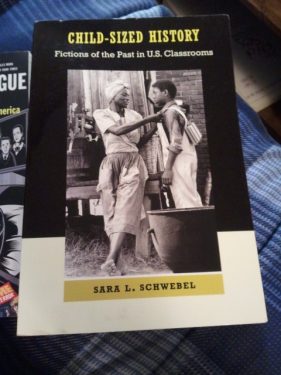 Sarah Schwebel, Child-Sized History: Fictions of the Past in US Classrooms (Vanderbilt UP, brand-new!) I met Sarah Schwebel at the annual conference of the Children’s Literature Association this past year, and thought this project sounded maximum intriguing. It’s a history of the way that historical novels for kids, like Johnny Tremain, Island of the Blue Dolphins, and Roll of Thunder, Hear My Cry, have been incorporated into the classroom curriculum; an argument that these books constitute a sort of “people’s history,” a secondary location where kids learn and think about the past, outside of the formally recognized “social studies” curriculum. I believe that the approach incorporates textual analysis along with a history of the way that the education profession has recognized and assessed these books. Although this surely fits some definition of a “work book,” it’s also one that I might not get to in the course of my day-to-day life; thus, the Bookbag nod.
Sarah Schwebel, Child-Sized History: Fictions of the Past in US Classrooms (Vanderbilt UP, brand-new!) I met Sarah Schwebel at the annual conference of the Children’s Literature Association this past year, and thought this project sounded maximum intriguing. It’s a history of the way that historical novels for kids, like Johnny Tremain, Island of the Blue Dolphins, and Roll of Thunder, Hear My Cry, have been incorporated into the classroom curriculum; an argument that these books constitute a sort of “people’s history,” a secondary location where kids learn and think about the past, outside of the formally recognized “social studies” curriculum. I believe that the approach incorporates textual analysis along with a history of the way that the education profession has recognized and assessed these books. Although this surely fits some definition of a “work book,” it’s also one that I might not get to in the course of my day-to-day life; thus, the Bookbag nod.
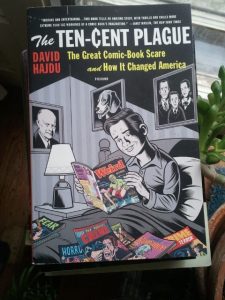 The Ten-Cent Plague: The Great Comic-Book Scare and How it Changed America, by David Hajdu (New York: FSG, 2008). This one’s for my students, who, last semester, when assigned what I thought was a perfectly awesome reading about juvenile delinquency and comic books (from James Gilbert’s A Cycle of Outrage), told me in no uncertain terms that the chapter was BO-RING. Now, if there’s any moral panic that should not be boring, it’s the comic-book scare—people testified about severed heads and poked-out eyes in front of Congress, for the Lord’s sake—so I am trying to find a new reading for that day. I liked Hajdu’s Positively Fourth Street, about Bob Dylan, Joan Baez, and Mimi and Richard Fariña, so I have high hopes that this narrative history will solve my own comic-book problem.
The Ten-Cent Plague: The Great Comic-Book Scare and How it Changed America, by David Hajdu (New York: FSG, 2008). This one’s for my students, who, last semester, when assigned what I thought was a perfectly awesome reading about juvenile delinquency and comic books (from James Gilbert’s A Cycle of Outrage), told me in no uncertain terms that the chapter was BO-RING. Now, if there’s any moral panic that should not be boring, it’s the comic-book scare—people testified about severed heads and poked-out eyes in front of Congress, for the Lord’s sake—so I am trying to find a new reading for that day. I liked Hajdu’s Positively Fourth Street, about Bob Dylan, Joan Baez, and Mimi and Richard Fariña, so I have high hopes that this narrative history will solve my own comic-book problem.
 Air: Or, Have Not Have by Geoff Ryman (St. Martin’s Griffin, 2004). This is a Highly Decorated and Recommended sf novel, about a woman who lives in an isolated village, and who is suddenly and radically connected to the rest of the world when a revolutionary technology called Air—which is something like the Internet in its implications, but operates through the air—is mistakenly tested on her village. A couple of times at Half Price Books I’ve snuck little tastes of this one, and finally concluded that I should commit for real. The premise sounds promising, and reviewers call Chung Mae (the protagonist) “one of the most fully rounded and complex female characters in fiction,” an entrepreneurial businesswoman who has little formal education but a ton of drive. Right now this is the only non-YA novel in my stack; much as I love the YA, I’m looking forward to delving into something a little more…complex.
Air: Or, Have Not Have by Geoff Ryman (St. Martin’s Griffin, 2004). This is a Highly Decorated and Recommended sf novel, about a woman who lives in an isolated village, and who is suddenly and radically connected to the rest of the world when a revolutionary technology called Air—which is something like the Internet in its implications, but operates through the air—is mistakenly tested on her village. A couple of times at Half Price Books I’ve snuck little tastes of this one, and finally concluded that I should commit for real. The premise sounds promising, and reviewers call Chung Mae (the protagonist) “one of the most fully rounded and complex female characters in fiction,” an entrepreneurial businesswoman who has little formal education but a ton of drive. Right now this is the only non-YA novel in my stack; much as I love the YA, I’m looking forward to delving into something a little more…complex.
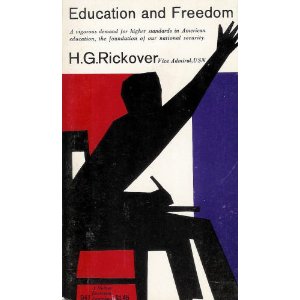 Finally, Hyman Rickover’s Education and Freedom (1960), which is blatantly un-fun dissertation research. This book by the “father of the nuclear navy” was an impassioned screed calling for improvement in standards in math and science education. Guess what? I’m finishing my next (and final!!) dissertation chapter this spring, about the passion that people felt while calling for improvement in standards in math and science education during the 1950s and 1960s. This is the book that I included in the Bookbag to make myself feel better about taking time away from dissertation writing. Do I get any fun points for the fact that when I Google image-searched for this cover, I got results including a photo of a small dog pooping on a copy of the Learning Annex catalog, a photo of a coffee mug full of marijuana, and a photo of a hairy streaker on the field at a soccer game? Google Images works in mysterious ways.
Finally, Hyman Rickover’s Education and Freedom (1960), which is blatantly un-fun dissertation research. This book by the “father of the nuclear navy” was an impassioned screed calling for improvement in standards in math and science education. Guess what? I’m finishing my next (and final!!) dissertation chapter this spring, about the passion that people felt while calling for improvement in standards in math and science education during the 1950s and 1960s. This is the book that I included in the Bookbag to make myself feel better about taking time away from dissertation writing. Do I get any fun points for the fact that when I Google image-searched for this cover, I got results including a photo of a small dog pooping on a copy of the Learning Annex catalog, a photo of a coffee mug full of marijuana, and a photo of a hairy streaker on the field at a soccer game? Google Images works in mysterious ways.
That’s it! I wish everyone a holiday full of unconstructed reading time, punctuated only by trips to the kitchen for more cookies and rousing family games of Celebrity.

